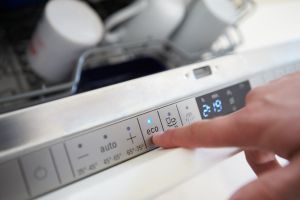These days dishwashers can be confusing machines, equipped with many different cycles and settings that you may not be entirely sure of how to use. If you’re confused when you see ‘Chef Wash’ or ‘SaniWash’, then you have come to the right place. Your dishes will never have been treated better after reading this Canstar Blue guide, giving you the rundown on dishwasher settings.
Dishwasher Cycles

While not every cycle featured will be available on your unit, this guide aims to offer a general idea of what type of wash to use when you’re putting on your next load. We’ll run through a number of cycles in this guide but note that specific names might vary on your dishwasher. Some common cycles include:
- Automatic / Sensor Wash
- Delicate / Glass / Light
- Eco Wash / Energy-Save
- Fast / Express / Quick / Turbo Wash
- Heavy / Intensive / Pots / Chef Wash
- Pre-wash / Rinse
- Sanitise
Automatic / Sensor Wash
The automatic wash cycle is becoming increasingly common on new dishwashers and might even wipe out all other cycles in the near future. This feature will detect the level of dirt on your dishes and automatically initiate an optimum cycle with regards to heat, intensity, and duration.
Things to know about this dishwasher setting:
- Best used for mixed loads and different soil levels.
- Temperature typically ranges between 45°C and 65°C.
- Has many different names – KitchenAid refers to it as ‘prowash’, while Miele calls it ‘Sensor Wash’.
Delicate / Glass Wash / Light
Fragile dishes, such as glassware, crystal or fine china require “delicate” care. This cycle typically employs a gentle spray to avoid knocking over any items and causing damage.
Things to know about this dishwasher setting:
- Best used for fragile items (i.e. glasses).
- Runs at low temperatures – around 40°C.
- Items washed on this cycle must still be dishwasher safe.
Eco Wash / Energy-Save
This dishwasher cycle is said to be environmentally-friendly, saving energy but often taking more time. This setting will restrict the amount of water used, while operating at lower temperatures.
Things to know about this dishwasher setting:
- Best used for mixed loads and soil levels.
- Runs at low temperatures – around 45°C.
- Sometimes this cycle will skip the heating process, air drying your dishes instead.
Fast / Express / Quick / Turbo Wash
This dishwasher setting is great if you’re in a rush, ensuring your crockery is cleaned in the fastest possible manner. The cycle uses either extra water or heat, or both, to clean your dishes in around an hour or less.
Things to know about this dishwasher setting:
- Best used for lightly soiled dishes.
- Operates at high temperatures – around 70°C.
- Does not deliver a thorough clean – do not use this cycle if you’re looking to do a deep clean of your dishes.
Heavy / Intensive / Pots / Chef Wash
As the name might suggest, this dishwasher cycle is designed for very dirty plates, pans and pots that would normally require soaking. It aims to clean baked-on food and grime by working at higher temperatures for longer periods of time.
Things to know about this dishwasher setting:
- Best used for very dirty dishes, crusted plates, and pots.
- Runs at high temperatures – around 70°C.
- Uses more water and energy than regular wash settings.
Pre-wash / Rinse
Most machines have programs with a pre-wash or rinse cycle that sprays water onto the dishes to loosen food particles. It won’t actually clean your dishes, it’s simply a good way to help prevent food residue from sticking to your plates.
Things to know about this dishwasher setting:
- Best used for pre-rinsing soiled dishes with baked-on food.
- It’s rare for heating to be used in this cycle.
- Some manufacturers suggest not using any detergent with this cycle.
Sanitise
Some dishwashers might be equipped with this high temperature program, aimed at offering deep cleaning results. This setting will deliver a hotter and longer wash than most other cycles.
Things to know about this dishwasher setting:
- Best used for sterilising dishes such as cutting boards and baby bottles.
- Runs at high temperatures – around 65°C.
- Commonly takes over an hour longer than regular cycles.
Understanding Dishwasher Cycles
These days dishwashers come equipped with an array of wash cycles that go by many different names, which can be confusing to the regular user. Don’t get stuck using solely the ‘Regular Wash’ setting, as you might be missing out on achieving optimum cleaning results. If you’re still trying to figure out what each setting does, have a look through your user manual. If you don’t have one handy, typically manufacturers have a PDF copy online. If your current dishwasher is fairly old, it may not feature all of these exciting settings. With this being the case, a new dishwasher may be what you’re after. To help you decide which machine is the best fit for you and your home, check out Canstar Blue’s best-rated dishwashers.
Original Author: Veronika Hleborodova




Share this article